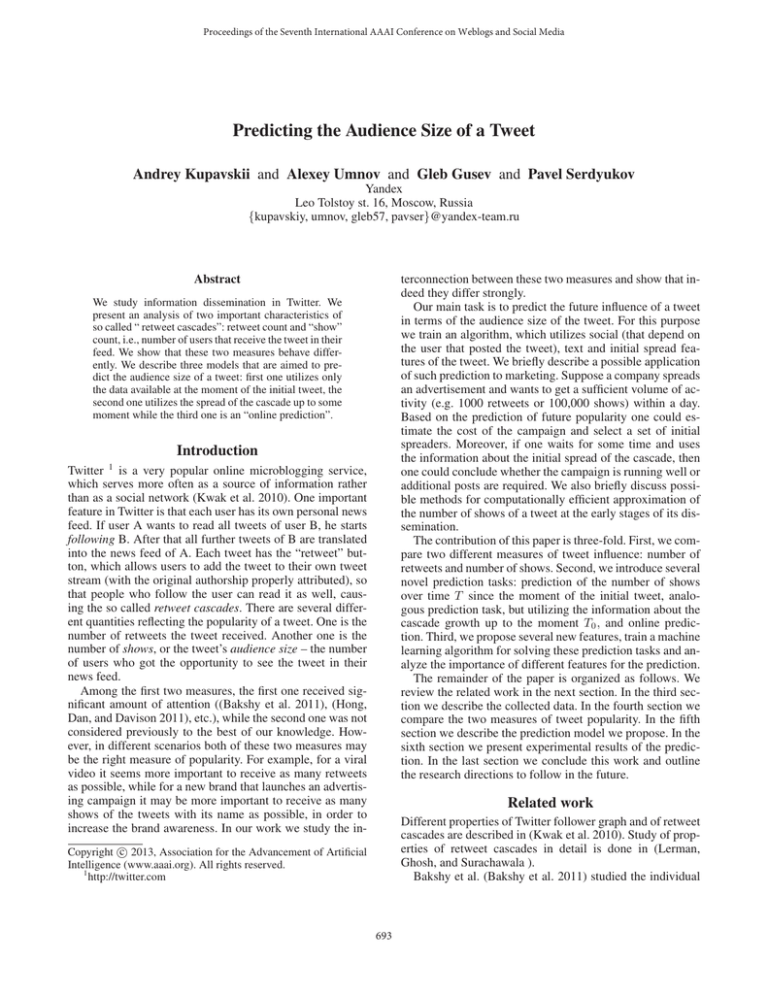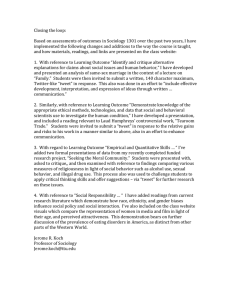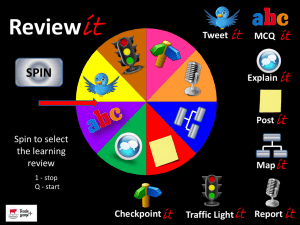
Proceedings of the Seventh International AAAI Conference on Weblogs and Social Media
Predicting the Audience Size of a Tweet
Andrey Kupavskii and Alexey Umnov and Gleb Gusev and Pavel Serdyukov
Yandex
Leo Tolstoy st. 16, Moscow, Russia
{kupavskiy, umnov, gleb57, pavser}@yandex-team.ru
Abstract
terconnection between these two measures and show that indeed they differ strongly.
Our main task is to predict the future influence of a tweet
in terms of the audience size of the tweet. For this purpose
we train an algorithm, which utilizes social (that depend on
the user that posted the tweet), text and initial spread features of the tweet. We briefly describe a possible application
of such prediction to marketing. Suppose a company spreads
an advertisement and wants to get a sufficient volume of activity (e.g. 1000 retweets or 100,000 shows) within a day.
Based on the prediction of future popularity one could estimate the cost of the campaign and select a set of initial
spreaders. Moreover, if one waits for some time and uses
the information about the initial spread of the cascade, then
one could conclude whether the campaign is running well or
additional posts are required. We also briefly discuss possible methods for computationally efficient approximation of
the number of shows of a tweet at the early stages of its dissemination.
The contribution of this paper is three-fold. First, we compare two different measures of tweet influence: number of
retweets and number of shows. Second, we introduce several
novel prediction tasks: prediction of the number of shows
over time T since the moment of the initial tweet, analogous prediction task, but utilizing the information about the
cascade growth up to the moment T0 , and online prediction. Third, we propose several new features, train a machine
learning algorithm for solving these prediction tasks and analyze the importance of different features for the prediction.
The remainder of the paper is organized as follows. We
review the related work in the next section. In the third section we describe the collected data. In the fourth section we
compare the two measures of tweet popularity. In the fifth
section we describe the prediction model we propose. In the
sixth section we present experimental results of the prediction. In the last section we conclude this work and outline
the research directions to follow in the future.
We study information dissemination in Twitter. We
present an analysis of two important characteristics of
so called “ retweet cascades”: retweet count and “show”
count, i.e., number of users that receive the tweet in their
feed. We show that these two measures behave differently. We describe three models that are aimed to predict the audience size of a tweet: first one utilizes only
the data available at the moment of the initial tweet, the
second one utilizes the spread of the cascade up to some
moment while the third one is an “online prediction”.
Introduction
1
Twitter is a very popular online microblogging service,
which serves more often as a source of information rather
than as a social network (Kwak et al. 2010). One important
feature in Twitter is that each user has its own personal news
feed. If user A wants to read all tweets of user B, he starts
following B. After that all further tweets of B are translated
into the news feed of A. Each tweet has the “retweet” button, which allows users to add the tweet to their own tweet
stream (with the original authorship properly attributed), so
that people who follow the user can read it as well, causing the so called retweet cascades. There are several different quantities reflecting the popularity of a tweet. One is the
number of retweets the tweet received. Another one is the
number of shows, or the tweet’s audience size – the number
of users who got the opportunity to see the tweet in their
news feed.
Among the first two measures, the first one received significant amount of attention ((Bakshy et al. 2011), (Hong,
Dan, and Davison 2011), etc.), while the second one was not
considered previously to the best of our knowledge. However, in different scenarios both of these two measures may
be the right measure of popularity. For example, for a viral
video it seems more important to receive as many retweets
as possible, while for a new brand that launches an advertising campaign it may be more important to receive as many
shows of the tweets with its name as possible, in order to
increase the brand awareness. In our work we study the in-
Related work
Different properties of Twitter follower graph and of retweet
cascades are described in (Kwak et al. 2010). Study of properties of retweet cascades in detail is done in (Lerman,
Ghosh, and Surachawala ).
Bakshy et al. (Bakshy et al. 2011) studied the individual
c 2013, Association for the Advancement of Artificial
Copyright Intelligence (www.aaai.org). All rights reserved.
1
http://twitter.com
693
all popularity.
In (Kwak et al. 2010) and (Cha et al. 2011) authors analyzed different user rankings and found that rankings of
users based on the number of followers and on the number
of retweeted messages differ greatly. We show that the analogous statement is true for the popularity of tweets, that is,
that the number of retweets and shows that a tweet received
behave in a different way.
Data
For our study we use two data sources. First, we collected a
sample of 12B public tweets over two month period March
1 2012 – April 30 2012 using data from the Twitter API. We
used the data from the first six weeks to calculate features
discussed in the fifth section. Namely, we extracted all the
ordered pairs of users who did a retweet via “retweet” button during these six weeks, and the time of each retweet and
used it to obtain the information about users’ retweet activity. In total we have 750M pairs of users and 1.5B retweets.
Out of the last two weeks of the two-month period we
obtained a stratified sample (see (Bakshy et al. 2011)) of
2000 tweets in English. That is, we put all the tweets that
were written during the first week (out of these two) and had
at least one retweet during these two weeks into 10 logarithmic bins according to the size of their retweet tree (as it
was on April 30). Then we extracted 200 tweets out of each
bin. Such a stratification procedure ensures that our sample
would reflect the full distribution of the non-zero cascade
sizes. Then we collected all the information about the corresponding cascades: the times of the retweets, identifiers of
corresponding participant users and the list of followers for
each participant. It contains 1.3M users that made retweet
and 135M unique followers. We use the information about
the 2000 cascades to calculate the exact number of shows,
to compare the two measures of tweet popularity and also to
train and test the machine learning algorithm.
Figure 1: Number of retweets and number of shows for 2000
epidemics
influence and tweet spread in Twitter. They found that the
best prediction of the size of retweet cascades that user generates is based on the average size of cascades of her tweets
in the past and that manually extracted content features do
not improve the quality of popularity prediction of the tweet.
We focus on the prediction of tweet’s popularity, although
all of our new factors can be used to measure individual influence. Unlike (Bakshy et al. 2011), we analyze the content of the tweet automatically, similar to how it was done
by (Petrovic, Osborne, and Lavrenko 2011). As (Bakshy et
al. 2011) claim, the features they used are relatively poor
predictors of the cascade size in the future. To improve the
quality of such prediction we make the problem more contextual and utilize the information about the initial spread of
the cascade, not only about the initial seed.
Prediction of the fact that the tweet will be retweeted at
least once was done in (Petrovic, Osborne, and Lavrenko
2011). Hong et al. (Hong, Dan, and Davison 2011) classified tweets into four categories according to the number
of retweets they received. In our work we try to distinguish
between the tweets of different “non-zero” popularity. We
focus on the prediction of the exact number of retweets
or shows rather than on the classification. The set of features we use includes those from these two works and from
(Bakshy et al. 2011). In addition, we consider several new
features: PageRank in the retweet graph and some timesensitive and cascade spread sensitive features.
In comparison to (Bakshy et al. 2011), (Hong, Dan, and
Davison 2011), we focus on the novel task of prediction of
the number of shows, i.e., the tweet’s audience, rather than
the number of retweets. Our regression task is more general
since we predict the number of retweets and shows the tweet
will gain during a certain time period. The use of novel features and the information about the initial spread of the tweet
helps to make the classification more accurate.
In (Kupavskii et al. 2012) authors predicted the exact
number of retweets the tweet receives. They introduced the
group of initial spread features. In this work, we focus on
the prediction of the number of shows. We use several new
features and study a novel task of “online” prediction of a
tweet’s audience size. Szabo and Huberman (Szabo and Huberman 2010) studied the activity of users and popularity of
news stories on Digg (http://digg.com). They found out that
the early popularity of news linearly correlate with the over-
Tweet popularity: Retweets vs. Shows
There are different ways to make a retweet in Twitter, but
now the most popular is via Twitter “retweet” button. We
examine the retweets of these type. Twitter shows only the
first retweet of this kind in the feed of a user. That is, given
an initial tweet of an arbitrary user, the feed of another user
A shows only the earliest retweet among all the retweets of
this tweet made by the followees of the user A.
The number of shows the tweet received is the number of
users who got the opportunity to see the tweet in their news
feeds. At first, we compare the two measures of influence for
the tweet. We calculate the coefficient of determination R2 .
The coefficient we got that way is equal to 0.45 (in general
it could be between 0 and 1), which means that these two
measures do not correlate strongly, and so they need different prediction algorithms. Figure 1 shows the dependency
between the number of retweets and shows as well as the
resulting approximation using linear regression.
Next, we randomly sampled 20 epidemics with large
amount of retweets and compared the growth of the number of shows and retweets over time. The resulting figures
694
We fix some small time period t0 to measure the increment of characteristics during this short period. Timesensitive features of the initial node (TS, 6 features): average global and local retweet ratios up to the moment t0
and T after a tweet posted by the user, show ratio up to the
moment t0 and T .
Features of the infected nodes up to the moment To (I,
12 features): |CT0 |, where CT0 is the set of users already
infected at the moment T0 (including the initial node); sums
of local and global retweet ratios of the users from CT0 ,
sum of average show ratios of the users from CT0 , sum of
weighted and unweighted PageRanks over users from CT0 ,
the number of shows at the moment T0 , show and retweet
transmissibility and the scale of the tweet at the moment T0 .
The transmissibility of the tweet is the ratio of the tweet popularity (in terms of retweets or shows) at the moment T0 and
average tweet popularity of the initial user at the moment
T0 . The scale of the tweet is the transmissibility of the tweet
multiplied by the average retweet or show ratio of the initial
user up to moment T . That is, this is the expected popularity
of the tweet given its spread up to T0 .
Approximating the number of shows
It is computationally complex to calculate the exact number
of shows the tweet received up to moment T even if you
know the information about the retweets of the tweet since
for that we need to store the lists of followers and intersect
them online. But we need to calculate the features quickly.
So we propose several different approximation algorithms
of the number of shows and compare them with each other.
The first approximation is the maximum number of followers among the participants of the epidemic. The second
one is the sum of the numbers of followers among the participants. The third one is the “uniform random intersection”
approximation. Consider a simple example. Suppose, the
epidemic consists of two users, A and B, with the number
of followers a and b respectively. We conjecture that the sets
of followers of A and B are chosen uniformly and independently from all sets of Twitter users of size a and b respectively. Then the expected intersection of these two sets is
equal to ab/M, where M = 100 million is the approximate
number of active users in Twitter. So the algorithm will estimate the number of shows for this epidemic as a+b−ab/M.
The fourth one is a random sampling algorithm, which is
taken from (Becchetti et al. 2006).
We compare the mean square root error for the approximation of the natural logarithm of the number of shows
(for the motivation see the next section) by these methods.
The random sampling has mean error 3.32, the maximum
— 1.32, the sum — 0.83 and the uniform random intersection — 0.81. The difference between the last two is not
large, because the random intersection of two sets of followers is smaller than the real intersection (due to clustering,
non-uniform distribution of the number of followees etc.).
Next we put forward the third prediction task, which
could be called “online prediction”. In this case we utilize
the information about the initial spread of the tweet except
for the exact number of shows the tweet received up to moment T0 , and instead of it use an approximate number of
shows. The following features will be used instead of the
Figure 2: Fraction of retweets and shows received over time
for a typical large epidemic
are similar, so on Figure 2 we present this dependency for
one typical epidemic. We expect that the prediction of the
number of shows should be more precise since at any given
time moment we are provided with a larger portion of tweet
dissemination measured in terms audience size.
Predicting the number of shows and retweets
We want to predict the popularity of the tweet at the moment T given the initial spread of the cascade up to the
moment T0 . Namely, we consider two prediction tasks for
each of two measures of tweet popularity we study. These
tasks differ in what kind of information about the cascade
we use. The first task uses only the information available
at the tweet share moment. The second task uses also the
information about the spread of the tweet up to the moment
T0 . For each task we learn the gradient boosted decision tree
model (Hastie, Tibshirani, and Friedman 2009). We use four
groups of features.
Social features of the initial node (S, 12 features): number of followers, friends, favorites, number of times the user
was listed, is the user verified, number of posts, the date
of account creation, average global and local retweet ratio
(from the training part of our dataset), show ratio, weighted
and unweighted PageRank in the retweet graph (Kupavskii
et al. 2012). The local retweet ratio is the average number of
retweets per tweet done by the user’s followers. Show ratio
of the initial user is the average of the number F , where F
is the sum of numbers of followers of users that retweeted
a given tweet of the initial user. To calculate the last two
features in this group we consider the retweet graph (based
on the training part of our dataset). For unweighted PageRank we assign equal weights to each edge A → B, for the
weighted PageRank we assign weights proportional to the
number of tweets of B retweeted by A. All of these features
except for two PageRanks and show ratio were used in (Bakshy et al. 2011) or (Petrovic, Osborne, and Lavrenko 2011).
Content features (C, 13 features): length of the tweet,
number of mentions, hashtags, URLs, positive and negative
terms, positive and negative smileys, exclamation and question marks, valence, arousal, dominance. The last three features are the sums of the corresponding weights of all tweet
words that appear in Affective Norms of English Words
(ANEW) dictionary. These features were used in (Petrovic,
Osborne, and Lavrenko 2011).
695
0, 15m
0, 1 w
retweet
0.954
1.22
rt user
0.956
1.218
show
0.84
1.056
sh user
0.836
1.047
sh text
2.826
2.78
15s, 15m
15s, 1w
Table 1: First prediction task
retweets
0.87
1.14
shows
0.827
1.022
online shows
0.816
1.014
Table 2: Second and the third prediction tasks
Conclusion
exact show count in the “online prediction”.
Approximate shows count up to the moment To (AS):
sum of followers of the users from CT0 , maximum number
of followers among users from CT0 , number of shows via
“uniform random intersection” and random sampling.
In this work we analyze two different measures of tweet popularity: the number of retweets and shows. We explain why
both of these measures are of independent interest and find
out that these two measures do not have a strong correlation.
We bring forward new tasks of predicting the number of
shows the tweet will receive (the size of its audience) at moment T since the initial tweet. We put forth three variations
of the prediction: one that utilizes information available at
the tweet share moment, the other utilizes the information
about the initial spread of the tweet up to some moment T0
and the third one uses only the features that are easily computable. We provide an analysis of the prediction and the
importance of different groups of features. We show that the
audience prediction is more precise that the prediction of the
number of retweets, which makes it a more reliable measure
of tweet popularity. We also study the problem of approximate calculation of the number of shows the tweet received.
In the future we plan to study another measure of tweet
influence that is suitable for tweets containing URLs. It is
the number of clicks the link receives and corresponds to the
size of the audience that not only had the opportunity to see
the tweet, or retweeted it, but which actually got engaged
with its content.
Experiments
We execute the prediction for T0 = 0 and 15 seconds and for
T = 15 minutes and one week. We fix t0 equal to 30 seconds.
We run a gradient boosted decision tree model with 200 iterations. We do 10-fold cross-validation. We approximate the
natural logarithm of the number of retweets and shows the
tweet receives by the moment T by minimizing mean square
error. We approximate the logarithm since we want to determine the order of epidemic size rather than the exact size.
Moreover, in this case, the algorithm is not biased towards
the prediction of the size of large epidemics.The results are
shown in Tables 1, 2. In tables we omit T, T0 and just write
their values. If the mean error is equal to x > 0, then,
roughly speaking, the actual number of retweets (shows) N
and the predicted value N 0 on average have the following
relation: e−x N 0 ≤ N ≤ ex N 0 . If, e.g., the error is between
0.7 and 1.1, the predicted popularity differs from the actual
one in between two and three times.
In Table 1 we present the results for the first task. The
first and the third column correspond to prediction that utilizes all features from sets S, C, TS. Columns 2,4,5 correspond to predictions of number of retweets and shows that
utilize either only user features (S, TS) or text features (C).
One can see that the prediction of the number of shows without content features is even a bit more accurate, which confirms the findings of (Bakshy et al. 2011), while prediction
that utilizes only content features gives relatively poor results (however, the prediction is still reasonable).
In Table 2 we present the results for the second and the
third tasks. One can see that, first, the prediction becomes
more precise if we utilize the information about the initial
spread (compare results from Table 1 and Table 2). Second, the quality of the online prediction for the number of
shows is a bit better. Third, the precision of the prediction of
the number of shows is higher than that for the number of
retweets (see both Table 1 and 2), confirming the intuition
from the fourth section.
We also present the quality of “online” prediction of the
number of shows the tweet got during T = one week using
different approximation strategies of the number of shows
up to moment T0 = 15 seconds: “no approximation” strategy (1.024), which means that we do not use any of the four
features for approximating the number of shows; only “random sampling” strategy (1.023), only “maximum” strategy
(1.015), only “sum” strategy (1.023), only “random intersection” strategy (1.02). We see that “maximum” and “random
intersection” strategies give the best results.
References
Bakshy, E.; Hofman, J.; Mason, W.; and Watts, D. 2011.
Identifying ’influencers’ on twitter. In WWW’11.
Becchetti, L.; Castillo, C.; Donato, D.; Leonardi, S.; and
Baeza-Yates, R. 2006. Using rank propagation and probabilistic counting for link based spam detection. In WebKDD’06.
Cha, M.; Haddadi, H.; Benevenuto, F.; and Gummadi, K.
2011. Measuring user influence in twitter: The million follower fallacy. In ICWSM’11.
Hastie, T.; Tibshirani, R.; and Friedman, J. 2009. The Elements of Statistical Learning. Springer.
Hong, L.; Dan, O.; and Davison, B. 2011. Predicting popular
messages in twitter. In WWW’11.
Kupavskii, A.; Ostroumova, L.; Umnov, A.; Usachev, S.;
Serdyukov, P.; Gusev, G.; and Kustarev, A. 2012. Prediction of retweet cascade size over time. In CIKM’12.
Kwak, H.; Lee, C.; Park, H.; and Moon, S. 2010. What is
twitter, a social network or a news media? In WWW’10.
Lerman, K.; Ghosh, R.; and Surachawala, T. Social contagion: An empirical study of information spread on digg and
twitter follower graphs. arXiv:1202.3162.
Petrovic, S.; Osborne, M.; and Lavrenko, V. 2011. Rt to win!
predicting message propagation in twitter. In ICWSM’11.
Szabo, G., and Huberman, B. 2010. Predicting the popularity of online content. Communications of the ACM
53(8):80–88.
696








